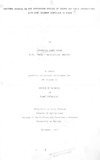| dc.description.abstract | Conditions influencing in vitro growth and sporulation of Cercospora sesami and C. sesamicola were investigated to determine appropriate techniques for producing adequate quantities of inocula for use in the creation of epiphytotics of the white and angular leaf spots of sesame during resistance screening programs.
Both fungi produced the largest colonies, and most abundant quantities of conidia on carrot leaf decoction potato dextrose agar, and sesame stem meal agar, respectively. Optimum media quantity for growth of both fungi was 35-ml per 9-cm diameter petri-plate. C. sesami sporulated most abundantly in plates holding 15-ml of media, but maximum conidial production by C. sesamicola was in those carrying 35-ml. Greatest mycelial and conidia! production by the two fungi occurred between pH 6-7. However, prolonged incubation widened the optimum pH range for growth and sporulation of both fungi. Prolonged incubation of C. sesami also improved sporulation but only until the 21st day. For C. sesamicola, every increase in the duration of incubation enhanced sporulation.
Optimum temperature for culturing both fungi was 25 0 C. Growth of both fungi was stimulated, and depressed by continuous light at all temperatures below and including 30° C, and at 35° C, respectively. Sporulation of C. sesami was greater under continuous dark and alternating light/dark cycles at temperatures below and including 25° C. At higher temperatures, illumination treatments did not produce significant effects on conidial production. For C. sesamicola, the largest number of conidia was observed under continuous light at all the tested temperatures. Although colonies of both fungi, were generally larger when propagated from mycelial fragments than from conidia, the reverse was true for sporulation. A general increase in growth of both fungi occurred following subculturing
irrespective of the form of inoculum used to initiate the cultures.
Speculation of the two fungi also followed a similar pattern when cultures were generated using conidia. For cultures grown using mycelial fragments, subculturing caused a general decline in sporulation of C. sesami, but improved that of C. sesamicola.
Pathogenicity of C. sesami and C. sesamicola on cultivated sesame (.Sesamum indicum) and on three wild species of Sesamum were also investigated under glasshouse conditions to provide proof for pathogenicity and establish host range of the two fungi. Within 12 to 28 days following inoculation, both fungi produced symptoms of infection on S. indicum, S. caIycinum and S. angolense, but only C. sesamicola caused infection on S. latifolium. Susceptible sesame plants were also inoculated in the glasshouse to study histopathological relationships of the two fungi. Within 3 to 12-hrs from inoculation, spores of both fungi germinated to give 1 to 6 germtubes per conidium. C. sesami did not produce appressoria prior to penetration in contrast to C. sesamicola. Penetration of both fungi into sesame leaf tissues was via the stomata and occurred 12 to 60-hrs after inoculation.
White and angular leaf spots were monitored in plots of 16 sesame accessions at Siaya Farmers Training Centre and Kibwezi Dryland Research Field Station to determine relative susceptibility of the accessions to the two diseases. Increases in percentage of diseased leaves and percent
defoliation fit the Gompertz model more closely than the logistic model. Rates of disease increase in infected leaves and defoliation as well as areas under disease progress curves (AUDPCs) varied among the sesame accessions studied. Sesame accessions with larger AUDPCs had generally
faster rates of disease progress, although this was not always the case.
The most susceptible accessions to both diseases were SPS 071 and SIK 134. Accession SPS 013, and accessions SIK 031 and SPS 045 exhibited the least susceptibility to white leaf spot, and angular leaf spot, respectively. These accessions are suggested as future standards for comparing reaction of other genotypes to the respective Cercospora leaf diseases of sesame | en_US |



